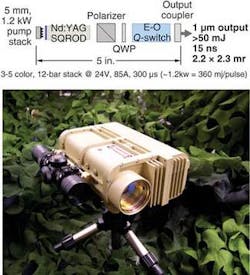LASER-DIODE ARRAYS: Multicolor uncooled diode array efficiently pumps Nd:YAG laser

Flashlamp pumping of Nd:YAG-based solid-state lasers is rapidly being replaced by laser-diode pumping. Although diodes can be matched to the gain medium and require less-elaborate cooling systems, the operating wavelength of laser diodes changes with operating temperature and consequently means that the laser diodes require active cooling. To stabilize the operating wavelength of these diodes, internal or external feedback can be used; however, such techniques have yielded only an operating-temperature window of approximately 40°C. An alternative approach demonstrated by engineers and researchers at Lasertel (Tucson, AZ) and at the Army Night Vision and Electronic Sensors Directorate (NVESD; Ft. Belvoir, VA) uses a multicolor uncooled laser-diode array with an intentionally widened emission spectrum coupled with an end-pumped Nd:YAG laser crystal that allows operation of the Nd:YAG laser over a temperature range of 100°C.
Because operating temperatures can reach extremes of -30°C and +70°C in addition to a wide range of mechanical shock and mechanical vibration profiles, the construction of an uncooled pump source requires special consideration. Traditional assemblies using soft solders and thermally unmatched materials are not adequate for these environmental conditions. As a result, the pump source used for the experimental pumping of a Nd:YAG laser crystal was a ruggedized 1.2 kW quasi-continuous-wave (QCW) laser-diode array.
25 nm spectral range
The array consisted of 12 5-mm-wide bars stacked at pitch of 0.4 mm to form an emission area of 4.4 × 5 mm. The bars were grown using solid-source molecular-beam epitaxy, which has been proved to have excellent wafer uniformity, wavelength control, and run-to-run repeatability. Bars with three to five different operating wavelengths were used in the QCW array to cover a spectral range of 790 to 815 nm. The array was constructed using Lasertel patented hard-solder technology and expansion-matched materials that withstand temperature ranges from -60°C to +100°C, temperature shocks of up to 200°C/minute, and mechanical shocks in excess of 50 g.
The solid-state laser design required very close coupling of the laser-diode pump array and the end of the Nd:YAG gain medium in an end-pumped configuration (see figure). The end-pumped laser design overcomes conventional laser-diode pump schemes in that it reduces size, weight, and cost by enabling the operation of the laser-diode array over military temperature ranges without the requirement for temperature control. The diode array was operated over a 100°C temperature span with no thermal control; the drive current to the laser-diode array was adjusted over this temperature range to keep a constant pump energy of about 360 mJ.
The Nd:YAG laser and the pump-laser components have been incorporated into what is called the Ultra Lightweight Designator (ULD)-a package weghing less than 5 lb, including the battery-which has been used in field tests to validate the pumped system, including successful live laser-guided bomb drops at Nellis Air Force Base (Las Vegas, NV).
The ULD is a laser-based target designator used to precisely identify a target for a smart missile. The guidance system on the smart missile uses sensors and electronics to detect the laser spot on the target and guide the missile to its target. Output-pulse frequencies for the designator and the electronics in the smart missile are synchronized by specific pulse-code sequences so that the missiles are only guided to a specific target.
The ULD with the Lasertel components produces more than 50 mJ/pulse, has a 15 ns pulse width, and operates continuously over a two-hour period on one set of batteries. Higher output energies for the ULDs are expected with further increase in the brightness of the pump sources.
REFERENCE
1. P. Thiagarajan et al., Solid State Lasers 1 session presentation at the Directed Energy Professional Society’s (www.deps.org) SSDLTR 2007 in Los Angeles, CA (June 2007).

Gail Overton | Senior Editor (2004-2020)
Gail has more than 30 years of engineering, marketing, product management, and editorial experience in the photonics and optical communications industry. Before joining the staff at Laser Focus World in 2004, she held many product management and product marketing roles in the fiber-optics industry, most notably at Hughes (El Segundo, CA), GTE Labs (Waltham, MA), Corning (Corning, NY), Photon Kinetics (Beaverton, OR), and Newport Corporation (Irvine, CA). During her marketing career, Gail published articles in WDM Solutions and Sensors magazine and traveled internationally to conduct product and sales training. Gail received her BS degree in physics, with an emphasis in optics, from San Diego State University in San Diego, CA in May 1986.